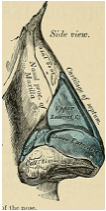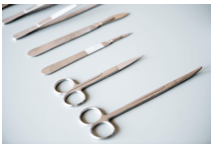Understanding Rhinoplasty Part 1: The Upper Nose Bump
3/19/2020
When thinking about having rhinoplasty surgery, many people are bothered by a bump or sift in the upper nose. This part of the nose is made of bone, while lower down the nose is supported by foter, bendable cartilage.
 Many people wonder Just how a plastic surgeon is able to take out a bone bump safely and
Many people wonder Just how a plastic surgeon is able to take out a bone bump safely and  effectively while leaving a smooth, improved shape that also allows for better breathing.
effectively while leaving a smooth, improved shape that also allows for better breathing.
Here is an image from the real Gray’s Anatomy textbook from the 1800’s. While in this drawing the nasal bones are quite straight, many rhinoplasty patients have a bump known as a dorsal hump) that curves outward.
The goal of rhinoplasty surgery is often to make those nasal bones more straight, instead of protruding outward. Just how much to reduce the nasal bones takes skill and judgement from your plastic surgeon. Here both the art and science of surgery come into play!
In this post op picture of a Dr. Suzman rhinoplasty patient, it is easy to imagine just how much bone was removed to make a beautifully straight profile. The bump also stretched the skin of the nose, making the airway more narrow, so after  surgery, the nose allowed for more air flow.
surgery, the nose allowed for more air flow.
Just how do doctors reduce the nasal bone? During surgery, patients are asleep with anesthesia medications. The surgeon also adds local anesthetic injections to make the nose numb, no less anesthesia medication is needed to keep the patient comfortable and asleep. The local anesthetic also contains epinephrine-- the natural compound made by the adrenal glands that constricts blood vessels, thereby reducing bleeding. Epinephrine ( also known as adrenaline) has many significant side effects such as rapid heart rate and potential skin injury, so it has to be given carefully by a skilled doctor who has years of training and experience as a physician. Another effect of epinephrine is dilating the lungs to let more air in-- that is why the same medication helps severe allergic reactions and is the medication in the Epi Pen.
 The surgeon makes incisions with a scalpel under and in the nose and VERY CAREFULLY lifts the skin and muscles and soft tissues off of the nasal bones using specially designed scissors and a curved instrument called a periosteal elevator. The bone can then be filed down with instruments called rasps.
The surgeon makes incisions with a scalpel under and in the nose and VERY CAREFULLY lifts the skin and muscles and soft tissues off of the nasal bones using specially designed scissors and a curved instrument called a periosteal elevator. The bone can then be filed down with instruments called rasps.
 For very large bumps or severely broken bones, a sharper instrument called an osteotome is used, along with the surgical assistant tapping it with a small hammer. This takes great skill!
For very large bumps or severely broken bones, a sharper instrument called an osteotome is used, along with the surgical assistant tapping it with a small hammer. This takes great skill!
Once the bump is filed down to about the height of the top on the nose (nasofrontal junction), the lower cartilages are operated on to make a straight nose ( more on this in Understanding Rhinoplasty Part II). Often the nasal bones need to  be narrowed at this point to re create a smoother contour with proper support of the nasal skin.
be narrowed at this point to re create a smoother contour with proper support of the nasal skin.
Sometimes the area where the nose joins the forehead is quite deep, and instead of reducing the nasal bump all the way down to this level, a small graft of cartilage is used to build up that area. Also, a non surgical rhinoplasty with filler injection such as Juvederm or Restylane can hide the bump by filling in this area.
We hope this explanation of surgical treatment of the nasal bump has been helpful. Please visit us at www.drsuzman.com for more information or email our team at [email protected].
Dr. Michael Suzman is a Plastic and Reconstructive Surgeon with WESTMED Medical Group in Westchester County NY, just north of NYC. He also has an office in Greenwich, CT and has operating privileges at Greenwich Hospital, White Plains Hospital as well as The AAAHC certified Rye Ambulatory Surgery Center. Dr. Suzman has performed thousands of plastic surgery procedures with a complete dedication to both safety and beautiful outcomes. He is a member of the American Society of Plastic Surgeons and The American Board of Plastic Surgeons.